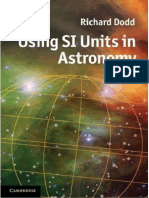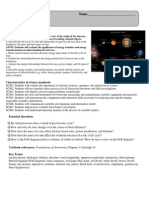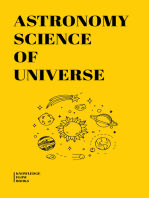Astronomy
Uploaded by
harshsexyAstronomy
Uploaded by
harshsexyThis article is about the scientific
study of celestial objects.
A giant Hubble mosaic of the Crab Nebula, a
supernova remnant
Astronomy is the scientific study of celestial objects (such as
stars, planets, comets, nebulae, star clusters and galaxies) and
phenomena that originate outside the Earth's atmosphere
(such as the cosmic background radiation). It is concerned with
the evolution, physics, chemistry, meteorology, and motion of
celestial objects, as well as the formation and development of
the universe.
Astronomy is one of the oldest sciences. Prehistoric cultures
left behind astronomical artifacts such as the Egyptian
monuments and Stonehenge, and early civilizations such as the
Babylonians, Greeks, Chinese, and Indians performed
methodical observations of the night sky. However, the
invention of the telescope was required before astronomy was
able to develop into a modern science. Historically, astronomy
has included disciplines as diverse as astrometry, celestial
navigation, observational astronomy, the making of calendars,
and even astrology, but professional astronomy is nowadays
often considered to be synonymous with astrophysics.
During the 20th century, the field of professional astronomy
split into observational and theoretical branches. Observational
astronomy is focused on acquiring data from observations of
celestial objects, which is then analyzed using basic principles
of physics. Theoretical astronomy is oriented towards the
development of computer or analytical models to describe
astronomical objects and phenomena. The two fields
complement each other, with theoretical astronomy seeking to
explain the observational results, and observations being used
to confirm theoretical results.
Amateur astronomers have contributed to many important
astronomical discoveries, and astronomy is one of the few
sciences where amateurs can still play an active role, especially
in the discovery and observation of transient phenomena.
Ancient astronomy is not to be confused with astrology, the
belief system which claims that human affairs are correlated
with the positions of celestial objects. Although the two fields
share a common origin and a part of their methods (namely, the
use of ephemerides), they are distinct.
Contents
· 1 Lexicology
o 1.1 Use of terms "astronomy" and
"astrophysics"
· 2 History
o 2.1 Scientific revolution
· 3 Observational astronomy
o 3.1 Radio astronomy
o 3.2 Infrared astronomy
o 3.3 Optical astronomy
o 3.4 Ultraviolet astronomy
o 3.5 X-ray astronomy
o 3.6 Gamma-ray astronomy
o 3.7 Fields not based on the
electromagnetic spectrum
o 3.8 Astrometry and celestial mechanics
· 4 Theoretical astronomy
· 5 Specific subfields
o 5.1 Solar astronomy
o 5.2 Planetary science
o 5.3 Stellar astronomy
o 5.4 Galactic astronomy
o 5.5 Extragalactic astronomy
o 5.6 Cosmology
· 6 Interdisciplinary studies
· 7 Amateur astronomy
· 8 Major problems
· 9 International Year of Astronomy 2009
· 10 See also
· 11 References
· 12 Bibliography
· 13 External links
Lexicology
The word astronomy (from the Greek words astron (ἄστρον),
"star" and -nomy from nomos (νόμος), "law" or "culture")
literally means "law of the stars" (or "culture of the stars"
depending on the translation).
Use of terms "astronomy" and "astrophysics"
Generally, either the term "astronomy" or "astrophysics" may
be used to refer to this subject. Based on strict dictionary
definitions, "astronomy" refers to "the study of objects and
matter outside the Earth's atmosphere and of their physical
and chemical properties" and "astrophysics" refers to the
branch of astronomy dealing with "the behavior, physical
properties, and dynamic processes of celestial objects and
phenomena". In some cases, as in the introduction of the
introductory textbook The Physical Universe by Frank Shu,
"astronomy" may be used to describe the qualitative study of
the subject, whereas "astrophysics" is used to describe the
physics-oriented version of the subject. However, since most
modern astronomical research deals with subjects related to
physics, modern astronomy could actually be called
astrophysics. Various departments that research this subject
may use "astronomy" and "astrophysics", partly depending on
whether the department is historically affiliated with a
physics department, and many professional astronomers
actually have physics degrees. One of the leading scientific
journals in the field is named Astronomy and Astrophysics.
History
A celestial map from the 17th century, by the
Dutch cartographer Frederik de Wit.
In early times, astronomy only comprised the observation and
predictions of the
motions of objects visible to the naked eye. In some locations,
such as Stonehenge, early cultures assembled massive
artifacts that likely had some astronomical purpose. In
addition to their ceremonial uses, these observatories could be
employed to determine the seasons, an important factor in
knowing when to plant crops, as well as in understanding the
length of the year.
Before tools such as the telescope were invented early study
of the stars had to be conducted from the only vantage points
available, namely tall buildings and high ground using the naked
eye. As civilizations developed, most notably in Mesopotamia,
China, Egypt, Greece, India, and Central America, astronomical
observatories were assembled, and ideas on the nature of the
universe began to be explored. Most of early astronomy
actually consisted of mapping the positions of the stars and
planets, a science now referred to as astrometry. From these
observations, early ideas about the motions of the planets
were formed, and the nature of the Sun, Moon and the Earth in
the universe were explored philosophically. The Earth was
believed to be the center of the universe with the Sun, the
Moon and the stars rotating around it. This is known as the
geocentric model of the universe.
A particularly important early development was the beginning
of mathematical and scientific astronomy, which began among
the Babylonians, who laid the foundations for the later
astronomical traditions that developed in many other
civilizations. The Babylonians discovered that lunar eclipses
recurred in a repeating cycle known as a saros.
Following the Babylonians, significant advances in astronomy
were made in ancient Greece and the Hellenistic world. Greek
astronomy is characterized from the start by seeking a
rational, physical explanation for celestial phenomena. In the
3rd century BC, Aristarchus of Samos calculated the size of
the Earth, and measured the size and distance of the Moon and
Sun, and was the first to propose a heliocentric model of the
solar system. In the 2nd century BC, Hipparchus discovered
precession, calculated the size and distance of the Moon and
invented the earliest known astronomical devices such as the
astrolabe. Hipparchus also created a comprehensive catalog of
1020 stars, and most of the constellations of the northern
hemisphere derive are taken from Greek astronomy. The
Antikythera mechanism (c. 150–80 BC) was an early analog
computer designed to calculating the location of the Sun,
Moon, and planets for a given date. Technological artifacts of
similar complexity did not reappear until the 14th century,
when mechanical astronomical clocks appeared in Europe.
During the Middle Ages, astronomy was mostly stagnant in
medieval Europe, at least until the 13th century. However,
astronomy flourished in the Islamic world and other parts of
the world. This led to the emergence of the first astronomical
observatories in the Muslim world by the early 9th century. In
964, the Andromeda Galaxy, the nearest galaxy to the Milky
Way, was discovered by the Persian astronomer Azophi and
first described in his Book of Fixed Stars. The SN 1006
supernova, the brightest apparent magnitude stellar event in
recorded history, was observed by the Egyptian Arabic
astronomer Ali ibn Ridwan and the Chinese astronomers in
1006. Some of the prominent Islamic (mostly Persian and Arab)
astronomers who made significant contributions to the science
include Al-Battani, Thebit, Azophi, Albumasar, Biruni, Arzachel,
Al-Birjandi, and the astronomers of the Maragheh and
Samarkand observatories. Astronomers during that time
introduced many Arabic names now used for individual stars. It
is also believed that the ruins at Great Zimbabwe and
Timbuktu may have housed an astronomical observatory.
Europeans had previously believed that there had been no
astronomical observation in pre-colonial Middle Ages sub-
Saharan Africa but modern discoveries show otherwise.
Scientific revolution
Galileo's sketches and observations of the Moon
revealed that the surface was mountainous.
During the Renaissance, Nicolaus Copernicus proposed a
heliocentric model of the solar system. His work was defended,
expanded upon, and corrected by Galileo Galilei and Johannes
Kepler. Galileo innovated by using telescopes to enhance his
observations.
Kepler was the first to devise a system that described
correctly the details of the motion of the planets with the Sun
at the center. However, Kepler did not succeed in formulating a
theory behind the laws he wrote down. It was left to Newton's
invention of celestial dynamics and his law of gravitation to
finally explain the motions of the planets. Newton also
developed the reflecting telescope.
Further discoveries paralleled the improvements in the size
and quality of the telescope. More extensive star catalogues
were produced by Lacaille. The astronomer William Herschel
made a detailed catalog of nebulosity and clusters, and in 1781
discovered the planet Uranus, the first new planet found. The
distance to a star was first announced in 1838 when the
parallax of 61 Cygni was measured by Friedrich Bessel.
During the 18–19th centuries, attention to the three body
problem by Euler, Clairaut, and D'Alembert led to more
accurate predictions about the motions of the Moon and
planets. This work was further refined by Lagrange and
Laplace, allowing the masses of the planets and moons to be
estimated from their perturbations.
Significant advances in astronomy came about with the
introduction of new technology, including the spectroscope and
photography. Fraunhofer discovered about 600 bands in the
spectrum of the Sun in 1814–15, which, in 1859, Kirchhoff
ascribed to the presence of different elements. Stars were
proven to be similar to the Earth's own Sun, but with a wide
range of temperatures, masses, and sizes.
The existence of the Earth's galaxy, the Milky Way, as a
separate group of stars, was only proved in the 20th century,
along with the existence of "external" galaxies, and soon after,
the expansion of the Universe, seen in the recession of most
galaxies from us. Modern astronomy has also discovered many
exotic objects such as quasars, pulsars, blazars, and radio
galaxies, and has used these observations to develop physical
theories which describe some of these objects in terms of
equally exotic objects such as black holes and neutron stars.
Physical cosmology made huge advances during the 20th
century, with the model of the Big Bang heavily supported by
the evidence provided by astronomy and physics, such as the
cosmic microwave background radiation, Hubble's law, and
cosmological abundances of elements.
Observational astronomy
The Very Large Array in New Mexico, an example of a radio
telescope
In astronomy, the main source of information about celestial
bodies and other objects is the visible light or more generally
electromagnetic radiation. Observational astronomy may be
divided according to the observed region of the
electromagnetic spectrum. Some parts of the spectrum can be
observed from the Earth's surface, while other parts are only
observable from either high altitudes or space. Specific
information on these subfields is given below.
Radio astronomy
Radio astronomy studies radiation with wavelengths greater
than approximately one millimeter. Radio astronomy is
different from most other forms of observational astronomy in
that the observed radio waves can be treated as waves rather
than as discrete photons. Hence, it is relatively easier to
measure both the amplitude and phase of radio waves, whereas
this is not as easily done at shorter wavelengths.
Although some radio waves are produced by astronomical
objects in the form of thermal emission, most of the radio
emission that is observed from Earth is seen in the form of
synchrotron radiation, which is produced when electrons
oscillate around magnetic fields. Additionally, a number of
spectral lines produced by interstellar gas, notably the
hydrogen spectral line at 21 cm, are observable at radio
wavelengths.
A wide variety of objects are observable at radio wavelengths,
including supernovae, interstellar gas, pulsars, and active
galactic nuclei.
Infrared astronomy
Infrared astronomy deals with the detection and analysis of
infrared radiation (wavelengths longer than red light). Except
at wavelengths close to visible light, infrared radiation is
heavily absorbed by the atmosphere, and the atmosphere
produces significant infrared emission. Consequently, infrared
observatories have to be located in high, dry places or in space.
The infrared spectrum is useful for studying objects that are
too cold to radiate visible light, such as planets and
circumstellar disks. Longer infrared wavelengths can also
penetrate clouds of dust that block visible light, allowing
observation of young stars in molecular clouds and the cores of
galaxies. Some molecules radiate strongly in the infrared. This
can be used to study chemistry in space; more specifically it
can detect water in comets.
Optical astronomy
The Subaru Telescope (left) and Keck Observatory (center) on
Mauna Kea, both examples of an observatory that operates at
near-infrared and visible wavelengths. The NASA Infrared
Telescope Facility (right) is an example of a telescope that
operates only at near-infrared wavelengths.
Main article: Optical astronomy
Historically, optical astronomy, also called visible light
astronomy, is the oldest form of astronomy. Optical images
were originally drawn by hand. In the late 19th century and
most of the 20th century, images were made using
photographic equipment. Modern images are made using digital
detectors, particularly detectors using charge-coupled devices
(CCDs). Although visible light itself extends from
approximately 4000 Å to 7000 Å (400 nm to 700 nm), the
same equipment used at these wavelengths is also used to
observe some near-ultraviolet and near-infrared radiation.
Ultraviolet astronomy
Ultraviolet astronomy is generally used to refer to
observations at ultraviolet wavelengths between approximately
100 and 3200 Å (10 to 320 nm). Light at these wavelengths is
absorbed by the Earth's atmosphere, so observations at these
wavelengths must be performed from the upper atmosphere or
from space. Ultraviolet astronomy is best suited to the study
of thermal radiation and spectral emission lines from hot blue
stars (OB stars) that are very bright in this wave band. This
includes the blue stars in other galaxies, which have been the
targets of several ultraviolet surveys. Other objects commonly
observed in ultraviolet light include planetary nebulae,
supernova remnants, and active galactic nuclei. However, as
ultraviolet light is easily absorbed by interstellar dust, an
appropriate adjustment of ultraviolet measurements is
necessary.
X-ray astronomy
X-ray astronomy is the study of astronomical objects at X-ray
wavelengths. Typically, objects emit X-ray radiation as
synchrotron emission (produced by electrons oscillating around
magnetic field lines), thermal emission from thin gases above
107 (10 million) kelvins, and thermal emission from thick gases
above 107 Kelvin. Since X-rays are absorbed by the Earth's
atmosphere, all X-ray observations must be done from high-
altitude balloons, rockets, or spacecraft. Notable X-ray
sources include X-ray binaries, pulsars, supernova remnants,
elliptical galaxies, clusters of galaxies, and active galactic
nuclei.
Gamma-ray astronomy
Gamma ray astronomy is the study of astronomical objects at
the shortest wavelengths of the electromagnetic spectrum.
Gamma rays may be observed directly by satellites such as the
Compton Gamma Ray Observatory or by specialized telescopes
called atmospheric Cherenkov telescopes. The Cherenkov
telescopes do not actually detect the gamma rays directly but
instead detect the flashes of visible light produced when
gamma rays are absorbed by the Earth's atmosphere.
Most gamma-ray emitting sources are actually gamma-ray
bursts, objects which only produce gamma radiation for a few
milliseconds to thousands of seconds before fading away. Only
10% of gamma-ray sources are non-transient sources. These
steady gamma-ray emitters include pulsars, neutron stars, and
black hole candidates such as active galactic nuclei.
Fields not based on the electromagnetic
spectrum
In addition to electromagnetic radiation, a few other events
originating from great distances may be observed from the
Earth.
In neutrino astronomy, astronomers use special underground
facilities such as SAGE, GALLEX, and Kamioka II/III for
detecting neutrinos. These neutrinos originate primarily from
the Sun but also from supernovae. Cosmic rays, which consist
of very high energy particles that can decay or be absorbed
when they enter the Earth's atmosphere, result in a cascade
of particles which can be detected by current observatories.
Additionally, some future neutrino detectors may also be
sensitive to the particles produced when cosmic rays hit the
Earth's atmosphere. Gravitational wave astronomy is an
emerging new field of astronomy which aims to use
gravitational wave detectors to collect observational data
about compact objects. A few observatories have been
constructed, such as the Laser Interferometer Gravitational
Observatory LIGO, but gravitational waves are extremely
difficult to detect.
Planetary astronomers have directly observed many of these
phenomena through spacecraft and sample return missions.
These observations include fly-by missions with remote
sensors, landing vehicles that can perform experiments on the
surface materials, impactors that allow remote sensing of
buried material, and sample return missions that allow direct
laboratory examination.
Astrometry and celestial mechanics
One of the oldest fields in astronomy, and in all of science, is
the measurement of the positions of celestial objects.
Historically, accurate knowledge of the positions of the Sun,
Moon, planets and stars has been essential in celestial
navigation and in the making of calendars.
Careful measurement of the positions of the planets has led to
a solid understanding of gravitational perturbations, and an
ability to determine past and future positions of the planets
with great accuracy, a field known as celestial mechanics. More
recently the tracking of near-Earth objects will allow for
predictions of close encounters, and potential collisions, with
the Earth.
The measurement of stellar parallax of nearby stars provides a
fundamental baseline in the cosmic distance ladder that is used
to measure the scale of the universe. Parallax measurements of
nearby stars provide an absolute baseline for the properties of
more distant stars, because their properties can be compared.
Measurements of radial velocity and proper motion show the
kinematics of these systems through the Milky Way galaxy.
Astrometric results are also used to measure the distribution
of dark matter in the galaxy.
During the 1990s, the astrometric technique of measuring the
stellar wobble was used to detect large extrasolar planets
orbiting nearby stars.
Theoretical astronomy
Theoretical astronomers use a wide Nucleosynthesis
variety of tools which include
analytical models (for example,
polytropes to approximate the
behaviors of a star) and
computational numerical simulations.
Each has some advantages. · Stellar nucleosynthesis
· Big Bang nucleosynthesis
Analytical models of a process are
· Supernova nucleosynthesis
generally better for giving insight · Cosmic ray spallation
into the heart of what is going on.
Numerical models can reveal the Related topics
existence of phenomena and effects · Astrophysics
that would otherwise not be seen. · Nuclear fusion
o R-process
Theorists in astronomy endeavor to o S-process
create theoretical models and figure · Nuclear fission
out the observational consequences
of those models. This helps
observers look for data that can refute a model or help in
choosing between several alternate or conflicting models.
Theorists also try to generate or modify models to take into
account new data. In the case of an inconsistency, the general
tendency is to try to make minimal modifications to the model
to fit the data. In some cases, a large amount of inconsistent
data over time may lead to total abandonment of a model.
-Harsh Ghelani,
+91 9833378545
You might also like
- Module-3 Association Analysis: Data Mining Association Analysis: Basic Concepts and AlgorithmsNo ratings yetModule-3 Association Analysis: Data Mining Association Analysis: Basic Concepts and Algorithms34 pages
- Gamma-Ray Astronomy With Cherenkov Telescopes662No ratings yetGamma-Ray Astronomy With Cherenkov Telescopes6625 pages
- Learning Module: Respiratory and Circulatory Systems Working With The Other Organ SystemsNo ratings yetLearning Module: Respiratory and Circulatory Systems Working With The Other Organ Systems152 pages
- (FREE PDF Sample) Stars and Stellar Processes 1st Edition Mike Guidry Ebooks67% (3)(FREE PDF Sample) Stars and Stellar Processes 1st Edition Mike Guidry Ebooks62 pages
- Weather Patterns and Severe Storms (Chapter 19No ratings yetWeather Patterns and Severe Storms (Chapter 1937 pages
- 1 - Chapter 04-The Origin of Modern AstronomyNo ratings yet1 - Chapter 04-The Origin of Modern Astronomy87 pages
- Lecture Outlines Powerpoint: Earth Science, 12ENo ratings yetLecture Outlines Powerpoint: Earth Science, 12E36 pages
- Cosmology Part I: The Homogeneous Universe: Hiranya V. PeirisNo ratings yetCosmology Part I: The Homogeneous Universe: Hiranya V. Peiris54 pages
- T Padmanabhan Theoretical Astrophysics Volume I Astrophysical Processes PDF0% (1)T Padmanabhan Theoretical Astrophysics Volume I Astrophysical Processes PDF621 pages
- Development of The Periodic Table of ElementsNo ratings yetDevelopment of The Periodic Table of Elements29 pages
- The Origin of Mass: Elementary Particles and Fundamental Symmetries 1st Edition John Iliopoulos All Chapter Instant Download100% (3)The Origin of Mass: Elementary Particles and Fundamental Symmetries 1st Edition John Iliopoulos All Chapter Instant Download62 pages
- St. Peter's College of Ormoc: Astronomy College Unit AY 2020 - 2021100% (1)St. Peter's College of Ormoc: Astronomy College Unit AY 2020 - 20217 pages
- Earth and Life Science Module Rev.2021 PDFNo ratings yetEarth and Life Science Module Rev.2021 PDF142 pages
- EARTH SCIENCE. Lesson 1 - Universe & Solar SystemNo ratings yetEARTH SCIENCE. Lesson 1 - Universe & Solar System65 pages
- Imaging and Detectors For Medical Physics Lecture 1: Medical ImagingNo ratings yetImaging and Detectors For Medical Physics Lecture 1: Medical Imaging29 pages
- Business Strategies & Their Marketing Implications: By: DR Shahinaz AbdellatifNo ratings yetBusiness Strategies & Their Marketing Implications: By: DR Shahinaz Abdellatif22 pages
- Session 3 (Quantitative Techniques - Sample Paper 2)No ratings yetSession 3 (Quantitative Techniques - Sample Paper 2)14 pages
- Communication Skills Among University StudentsNo ratings yetCommunication Skills Among University Students6 pages
- Standards For 7-Day and 28-Day Strength Test ResultNo ratings yetStandards For 7-Day and 28-Day Strength Test Result1 page
- Forouzan MCQ in Introduction To Data Communications and NetworkingNo ratings yetForouzan MCQ in Introduction To Data Communications and Networking13 pages
- 11-09-2022 - SR - Super60 - Jee-Adv (2020-P2) - RPTA-01 - Key & Sol'sNo ratings yet11-09-2022 - SR - Super60 - Jee-Adv (2020-P2) - RPTA-01 - Key & Sol's10 pages
- KDS 14 20 64 Design Standard For Structural Plain ConcreteNo ratings yetKDS 14 20 64 Design Standard For Structural Plain Concrete11 pages
- AE Operation and Maintenance Manual of 170 Series Marine Diesel EngineNo ratings yetAE Operation and Maintenance Manual of 170 Series Marine Diesel Engine123 pages
- MEDIATION TEAM’S SEVENTEENTH NOTICE AND REPORTNo ratings yetMEDIATION TEAM’S SEVENTEENTH NOTICE AND REPORT7 pages
- ANDUALEM DEMISSIE DEGU The Effect of Working Capital Management On The Profitability of Manufacturing Companies in Ethiopia100% (1)ANDUALEM DEMISSIE DEGU The Effect of Working Capital Management On The Profitability of Manufacturing Companies in Ethiopia78 pages
- Corporate and Business Law (LW-ENG) : Syllabus and Study GuideNo ratings yetCorporate and Business Law (LW-ENG) : Syllabus and Study Guide15 pages
- Violino 1 Signed, Sealed, Delivered - Stevie WonderNo ratings yetViolino 1 Signed, Sealed, Delivered - Stevie Wonder1 page
- Module-3 Association Analysis: Data Mining Association Analysis: Basic Concepts and AlgorithmsModule-3 Association Analysis: Data Mining Association Analysis: Basic Concepts and Algorithms
- Learning Module: Respiratory and Circulatory Systems Working With The Other Organ SystemsLearning Module: Respiratory and Circulatory Systems Working With The Other Organ Systems
- (FREE PDF Sample) Stars and Stellar Processes 1st Edition Mike Guidry Ebooks(FREE PDF Sample) Stars and Stellar Processes 1st Edition Mike Guidry Ebooks
- Cosmology Part I: The Homogeneous Universe: Hiranya V. PeirisCosmology Part I: The Homogeneous Universe: Hiranya V. Peiris
- T Padmanabhan Theoretical Astrophysics Volume I Astrophysical Processes PDFT Padmanabhan Theoretical Astrophysics Volume I Astrophysical Processes PDF
- The Origin of Mass: Elementary Particles and Fundamental Symmetries 1st Edition John Iliopoulos All Chapter Instant DownloadThe Origin of Mass: Elementary Particles and Fundamental Symmetries 1st Edition John Iliopoulos All Chapter Instant Download
- St. Peter's College of Ormoc: Astronomy College Unit AY 2020 - 2021St. Peter's College of Ormoc: Astronomy College Unit AY 2020 - 2021
- Imaging and Detectors For Medical Physics Lecture 1: Medical ImagingImaging and Detectors For Medical Physics Lecture 1: Medical Imaging
- Business Strategies & Their Marketing Implications: By: DR Shahinaz AbdellatifBusiness Strategies & Their Marketing Implications: By: DR Shahinaz Abdellatif
- Session 3 (Quantitative Techniques - Sample Paper 2)Session 3 (Quantitative Techniques - Sample Paper 2)
- Standards For 7-Day and 28-Day Strength Test ResultStandards For 7-Day and 28-Day Strength Test Result
- Forouzan MCQ in Introduction To Data Communications and NetworkingForouzan MCQ in Introduction To Data Communications and Networking
- 11-09-2022 - SR - Super60 - Jee-Adv (2020-P2) - RPTA-01 - Key & Sol's11-09-2022 - SR - Super60 - Jee-Adv (2020-P2) - RPTA-01 - Key & Sol's
- KDS 14 20 64 Design Standard For Structural Plain ConcreteKDS 14 20 64 Design Standard For Structural Plain Concrete
- AE Operation and Maintenance Manual of 170 Series Marine Diesel EngineAE Operation and Maintenance Manual of 170 Series Marine Diesel Engine
- ANDUALEM DEMISSIE DEGU The Effect of Working Capital Management On The Profitability of Manufacturing Companies in EthiopiaANDUALEM DEMISSIE DEGU The Effect of Working Capital Management On The Profitability of Manufacturing Companies in Ethiopia
- Corporate and Business Law (LW-ENG) : Syllabus and Study GuideCorporate and Business Law (LW-ENG) : Syllabus and Study Guide
- Violino 1 Signed, Sealed, Delivered - Stevie WonderViolino 1 Signed, Sealed, Delivered - Stevie Wonder

























































































